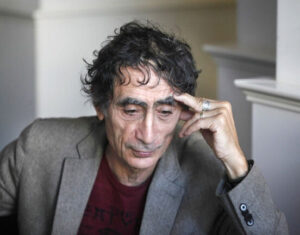Book Summary: When The Body Says No
Gabor Maté’s book When the Body Says No explores the profound connection between emotional stress, repressed emotions, and chronic illness. He points to the body and mind being one, and when needs are ignored, the body often “says no” in the form of illness. Drawing on research in psychoneuroimmunology, trauma studies, and psychosomatic medicine — along with clinical case studies — Maté examines how personality traits, childhood events, and societal conditioning contribute to illness.
When the Body Says No is relevant for those suffering chronic conditions, as it aligns with the principles that we are working with in mindbody healing. This is a great book to consider if you would like help understanding why there is a need for healing work for neuroplasticity and nervous system rewiring.
Pause here and take a deep breath. Place a hand on your heart. Say to yourself on the exhale: 'Body, I am here.'
The Mind-Body Connection in Illness
In this book, Maté presents research and case studies suggesting that emotional repression and chronic stress may contribute to diseases such as cancer, ALS, autoimmune disorders, and chronic conditions. He highlights how hidden stressors — such as people-pleasing tendencies, perfectionism, or unprocessed grief — impact the immune system and overall health.
The salient stressors in the lives of most human beings today — at least in the industrialized world — are emotional.
Gabor Maté
The MindBody Connection and Emotional Healing
The insights in When the Body Says No align with the core principles of The Mindbody Syndrome (TMS) and nervous system rewiring. Maté’s research helps illustrate why chronic symptoms often persist even when medical interventions fail — because unprocessed stress patterns can keep the nervous system in a state of dysregulation. Healing is not about ignoring symptoms but about recognising that buried emotions and chronic stressors may be playing a role in physical conditions. This is why mindbody healing focuses on restoring the nervous system, neuroplasticity and emotional healing.
- This book directly supports The Mindbody Syndrome (TMS), neuroplasticity and nervous system rewiring.
Maté suggests that chronic illness is often linked to patterns of self-denial, where individuals suppress their needs to maintain relationships or meet external expectations. His approach encourages self-inquiry with support, allowing you to recognise and release long-held stressors and emotional burdens.
This process is quite a journey and can sometimes feel overwhelming. Healing is not just about uncovering past pain — it is about how to release the burden that has been carried for so long as a survival mechanism. For this reason, the healing journey needs a certain amount of building resilience, restoring nervous system regulation, and creating new, supportive patterns to create a foundation for deeper inner work.
There are structured, compassionate ways to engage with this work that focus on building stability first — so that the journey feels like an expansion of safety and resilience rather than an emotional flood that leads to burnout.
The Development of the Personality Type
Maté argues that early childhood experiences shape stress responses, nervous system regulation, and patterns of self-denial. He shares that many individuals with chronic illness have histories of emotional neglect or were expected to suppress emotions to maintain family harmony.
Maté identifies common personality traits in individuals with chronic illness, including:
- People-pleasing
- Perfectionism and self-criticism
- Repressed emotions
One of the case studies Maté shares is about a woman named Veronica, a dedicated caregiver who was diagnosed with a severe autoimmune condition. From a young age, she had learned to prioritise others’ needs above her own, often neglecting her own emotions to maintain family harmony. Her role as the “strong one” in the family meant she rarely expressed distress, even when she experienced deep emotional pain. Over the years, this pattern of self-denial led to chronic stress, which, according to Maté, contributed to the breakdown of her immune system. Through his work with her, he observed that her body’s illness was mirroring the emotional suppression she had lived with for decades.
Veronica’s story highlights the profound connection between repressed emotions and physical health. Like so many who develop these personality traits, she needed support to adjust inherited beliefs, build nervous system resilience, and gradually learn how to set boundaries—essential steps toward reconnection with herself.
The science Behind The Book
Maté’s work is grounded in research from fields such as psychoneuroimmunology, which studies how stress and emotions impact immune function, and trauma science, which explores the long-term effects of early adversity on the nervous system. He references studies like the Adverse Childhood Experiences (ACE) Study, which links early emotional stress to increased risks of chronic illness, as well as research on cortisol dysregulation, showing how prolonged stress can weaken the immune system.
Maté’s work is supported by research in fields like epigenetics, which explores how stress and trauma can alter gene expression over time, potentially leading to increased susceptibility to chronic illness. Additionally, his findings align with polyvagal theory, which explains how our autonomic nervous system adapts to chronic stress and past emotional experiences, affecting immune function and overall health. Studies also show that chronic stress can dysregulate the gut-brain axis, disrupting digestion and inflammation levels, which may contribute to many chronic conditions.
His perspective is not universally accepted in mainstream medicine, but his synthesis of these findings does provide a compelling case for the role of hidden stressors in illness. For those open to exploring the mindbody connection, his work can offer a deeper understanding of how emotional patterns may be influencing their health.
Key Takeaways from When the Body Says No
Gabor Maté’s When the Body Says No provides insight into the connection between emotional repression, nervous system dysregulation, and chronic illness, offering a foundation for understanding why emotional healing is an essential part of recovery. He encourages people to learn about boundary-setting and saying “no” without guilt. He suggests that when individuals are trained into a life of suppressing their own needs, it leads to chronic stress and illness.
When The Body Says No offers a foundational understanding of why emotional work is essential for chronic illness recovery. Maté emphasizes that healing is not just about managing symptoms — it involves reclaiming authenticity and emotional expression.
Meet The Author of the Book: Gabor Maté
Gabor Maté is a retired Canadian physician (M.D.), having worked as a family doctor and in palliative care before shifting his focus to addiction, trauma, and mind-body health. His approach emphasizes how we use coping mechanisms for deep-seated emotional pain often rooted in negative childhood events and trauma. He is very open about his own coping mechanisms, particularly his own addictions and “addict behaviours”.
From his early life in Nazi-occupied Budapest to his involvement in the radical student movements of the 1960s, and later working with drug addiction and mental health in Vancouver’s most troubled areas, Maté sees medicine as a holistic, dialectical practice. He emphasises the social as much as the individual when understanding disease and dysfunction.

"If somebody decides that the price of suppressing themselves has become too much, they can change. It's a question of getting conscious, but change is possible"
Gabor Maté
Amari's Perspective
Tip: Read with Care
While Dr. Gabor Maté’s insights into the connection between emotions and illness are valuable, his books can feel quite intense, especially for those already navigating deep emotional wounds. Some may find his case studies enlightening, while others may experience them as emotionally triggering. His books contain many case studies that can be difficult to read, especially for those already carrying deep wounds of their own.
While his theories can provide helpful context for understanding the mindbody connection, it isn’t necessary to read his work in order to heal. What truly matters is restoring safety to the nervous system, building resilience, and learning how to begin reconnecting with yourself.
One of the biggest takeaways for me was realising that addiction isn’t just about substances, like drugs and alcohol — it can also be about work, perfectionism, people-pleasing, or constantly striving to prove our worth. Maté helped me see that we are all engaging in some form of addiction, whether to external validation, achievement, or distraction. These patterns may feel like personality traits, but they are often learned survival strategies from childhood.
If these ideas resonate with you but feel overwhelming to explore alone, I’d love to help. Healing is not about rushing into painful emotions — it’s about finding safe ways to reconnect with yourself. If you’re looking for guidance, I invite you to try a Guided Healing Practice to support your journey with self-gentleness and care.
Be kind to yourself. You’re not broken. Your body and mind have been doing their best to keep you safe. Healing is not about forcing change but about gently shifting these patterns.
Next Steps: Where to Go From Here
Come back to these insights whenever you need them. Healing happens through repetition, through revisiting what resonates and allowing new understandings to settle with time.
If this book summary has sparked something in you, you might enjoy exploring:
💗 A Guided Somatic Tracking Practice – There are short exercises on the blog that I have created to help you shift out of fight-flight-freeze and into a space of ease.
💗 Visit the Resources Hub – A central space where you’ll find blog posts, guided healing practices, and in-depth articles and mini-courses to help you deepen your understanding of mindbody healing.
Trust that what you have started here is enough. There is no rush, no urgency – only an unfolding journey, one step at a time.
This is the beginning of something beautiful. Keep going, gently 💗
💗 Meet The Author 💗

Amari Love
Amari Love is a coach and writer who specialises in mind-body-spirit healing for chronic illness. With postgraduate degrees in English Literature, Writing, and Film, and having completed additional studies in Somatic Healing, Trauma Recovery, Gut Health and Meditation, she brings a rare blend of intellectual insight and heart-led guidance. Drawing deeply from her own journey of recovery after decades of chronic invisible illness, cancer and Longcovid, her work is grounded in the principles of TMS (The Mindbody Syndrome), Neuroplasticity, and Emotional Integration — supported by a spiritual approach to wholeness and inner alignment.
Amari is a registered health coach with the UKI Health Coaching Association, reflecting her commitment to high standards of integrity and compassionate, science-backed care. She also cares deeply about making this path more visible — so that others, and future generations, have access to real answers that go beyond managing symptoms.
This work is here to help you rewire your brain, restore the nervous system, and reclaim a life of clarity, balance, and peace.
Disclaimer: The content in this article is shared for educational and reflective purposes only. It is not intended to replace personalised medical advice, diagnosis, or treatment. Please consult a qualified healthcare professional before making decisions about your health or wellbeing.


